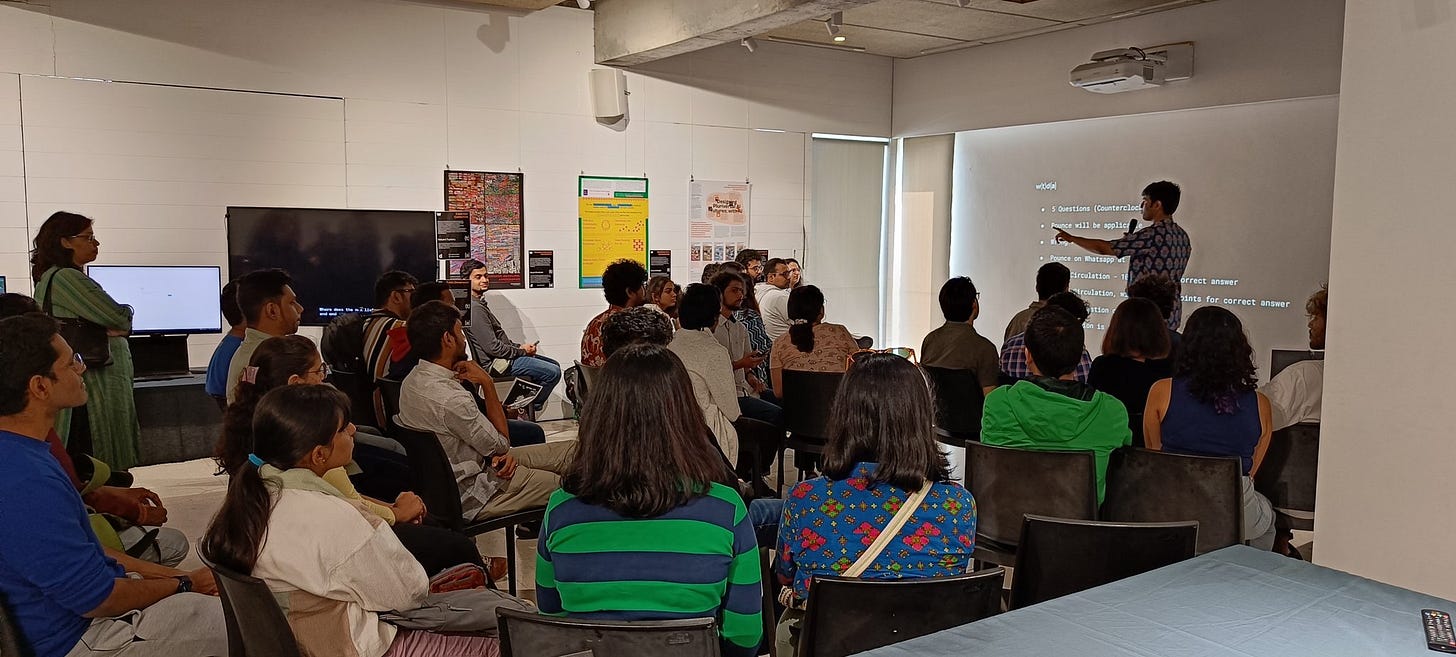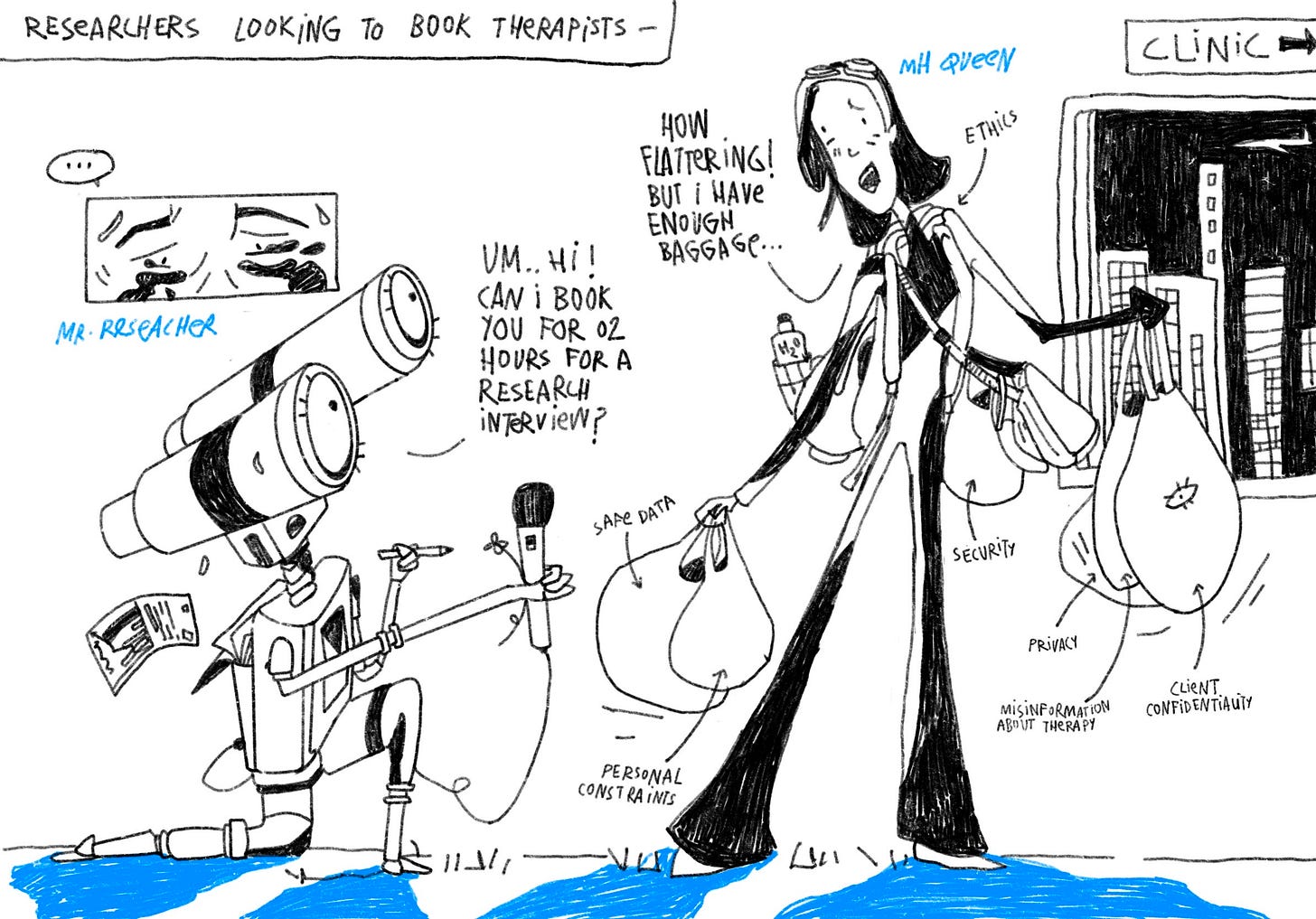Digest #4 – Border Objects in a bordered world
Psych, Tech, & Design collabs, career paths, and communities
👋 Hi you, I’m Harshali and you’re reading the weekly digest on the mental health tech economy.
Last week was a real test of consistency for me - I dropped the ball on publishing this newsletter on time. It’s been challenging to return to the writing routine. But ah well, here we are. You got to start somewhere again, right?
Today’s digest in a nutshell:
Where psychology meets art and tech
What are Boundary Objects?
Boundary Objects in Psychology
Examples of Boundary Objects in mhTech
One interesting journey
Where psychology meets art and tech
Story time.
In the end days of November of 2022, a bunch of us friends organised a tech and art fair at BIC Bangalore.
While(tech)do{art} or WTDA was an attempt for us friends-turned-creative-collective to find folks who were producing creative tech-works but could not find a ‘productive’ use for it in their tech jobs.
It was a one day art+tech fair that had displays, zine stalls, interactive projects, and a quiz. Around 25 artists - most from India, few from around the world - showcased and participated.
My personal motivation to organise a WTDA, especially in Bangalore, was to find more people with interests in psychology and tech.
I was a designer turned product manager at the time - a tech baby in the world of big management words. It was rather hard to get tech people to indulge in art projects themed in behavioural science, so WTDA proved to be a fertile ground!
I share this story because last week, a couple of us organisers caught up on life and other things as we wondered about the future of WTDA. Where does an art-tech fair go from here?
For me the question was – how can we collectively produce and display art that is a commentary on the socio-technical systems we occupy and its implications with our personhood?
We initiated a checkin email thread with the WTDA community and received some wonderful responses. One of them has stayed with me —
…academic research and crochet, PMs (product managers) and 3D printing, psychologists and designers; all making things together and pushing the idea of materiality of a boundary object.
What are Boundary Objects?
Simply put, boundary objects are artefacts that exist between two or more worlds, that help people of those worlds inter-mingle and communicate with each other.
Think of this object as building a bridge – between professions, organisations, and even individuals from different cultures.
Here’s a short explanation:
Examples of boundary objects are:
Maps - a restaurant uses a map to guide diners on a food journey
Specimen, field notes - they guide various teams toward a single source of truth
An intake form - guides the client and the provider towards articulating shared goals of therapy
Boundary Objects in Psychology
The part that piques my interest the most is that ✨ you can create boundary objects✨
When a mental health provider creates a presentation for group therapy participants, they create a boundary object.
A mobile app that guides users into regulated breathing is a boundary object.
From a lay-person’s perspective, understanding abstract psychological concepts like mentalisation and critical thinking is often challenging. Using boundary objects to demonstrate and practise these concepts might pave a path for effective provider-client communication.
If using medias together creates a richer information transfer, then creating boundary objects in psychology is basically a design x psych collab!
What might boundary objects in mhTech look like?
I’m thinking out loud here, humour me a bit:
🖍️ Perhaps visual designers can create illustrations of examples and scenarios used in group therapy. These illustrations could be region/ culture specific, linguistically appropriate and ethnically inclusive - creating a bridge of visual language between providers and clients during sessions.
📼 Perhaps therapy recordings could be masked for personal identity, and closed captioned for language switches. A secured, masked version of the recording would act as a boundary object between the provider and their supervisors and peers. It would facilitate an effective and secure way to recreate the session for feedback.
🎞️ Perhaps expert providers could recreate frequently encountered challenging scenarios with actors to create skits. Such skits would act as boundary objects between psych educators and students.
Have you encountered a boundary object that speaks to Psychology using Tech and Design? Or do you have an idea for developing one?
📌 This newsletter is read by 80+ people from clinical, art, design, engineering, communications and research background. If you have a brief and are looking for people with complementary skills, I’d love to help you find them! 📌
One interesting journey
The funnest side quest of writing this newsletter has been meeting really cool people. Earlier this year a LinkedIn exchange introduced me to Vinamra Vasudeva.
When we met, Vinamra had just begun working with NIMHANS. Her project there involved creating digital wellbeing products aimed at student wellbeing and suicide prevention.
Vinamra is a gold medalist in neuropsychology. Prior to her role at NIMHANS, she worked at an NGO, a hospital, and a startup!
My journey continued through various startups, where I honed my skills in team management, organisational creativity, and product development. My first full-time role post-masters plunged me into the ed-tech sector, where I worked with interdisciplinary teams and embraced design, gamification, and the pressures of startup life.
Transitioning into a counseling psychologist felt like finding my true calling. However, my love for the startup world led me to move from ed-tech to skill-tech, focusing on assessing skills and building a community of learners. This blend of experiences shaped my unique approach toward mhTech.
I’ve created interactive content for digital interventions, conducted market research for learner cohorts, and developed a mental health playbook for stress management and skill learning. All this while maintaining my role as an online therapist.
My content creation philosophy is simple: Write what you want to read. While companies might define mhTech users by age and other demographic factors, I create content for anyone seeking a reflection, a thought, or a feeling. My aim is to make mental health concepts accessible, engaging, and deeply personal.
In essence, my journey has been a blend of therapy, innovative content creation, and a dash of startup energy.
The mental health industry (as well as the tech industry) today demand constant reinvention of one’s professional self in order to remain relevant. In that light, I found Vinamra’s elasticity and high career agency very enterprising, and a great example of what psych roles look like in the tech world.
You can connect with Vinamra on her LinkedIn or via her website.
Weekly conundrums by @ditiiee
This week I’ll be attending the Virtual Coffee, the first online event hosted by OHT Mental Health Specialist Network.
One Health Tech (OHT) is a London based grassroots, volunteer-led, global community in the healthcare-tech sector. I was first introduced to OHT by my pen-pal Maura, who’s a fellow with the group. Kevin Flanagan, who is leading the OHT Mental Health Specialist Network, is himself an entrepreneur in the mhTech space. The team are very enthusiastic to have people from around the globe join the network.
I like OHT for being a great community space (via their slack and twitter) for mhTech professionals to meet each other.
Did you enjoy this read? Consider sharing it with a friend who is interested in mhTech!
Do you have thoughts/ feelings/ questions/ ideas? Lets have a 15 min video chat. 💌
See ya next week!
From a windy Bangalore 🍃
Harshali








